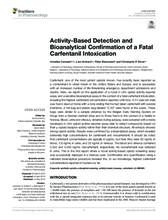Carfentanil, one of the most potent opioids known, has recently been reported as a contaminant in street heroin in the United States and Europe, and is associated with an increased number of life-threatening emergency department admissions and deaths. Here, we report on the application of a novel opioid activity reporter assay and a sensitive bioanalytical assay in the context of a fatal carfentanil intoxication, revealing the highest carfentanil concentrations reported until now. A 21-year-old male was found dead at home with a note stating that he had taken carfentanil with suicidal intentions. A foil bag and plastic bag labeled "C.50" were found at the scene. These bags were similar to a sample obtained by the Belgian Early Warning System on Drugs from a German darknet shop and to those found in the context of a fatality in Norway. Blood, urine and vitreous, obtained during autopsy, were screened with a newly developed opioid activity reporter assay able to detect compounds based on their μ-opioid receptor activity rather than their chemical structure. All extracts showed strong opioid activity. Results were confirmed by a bioanalytical assay, which revealed extremely high concentrations for carfentanil and norcarfentanil. It should be noted that carfentanil concentrations are typically in pg/mL, but here they were 92 ng/mL in blood, 2.8 ng/mL in urine, and 23 ng/mL in vitreous. The blood and vitreous contained 0.532 and 0.300 ng/mL norcarfentanil, respectively. No norcarfentanil was detected in urine. This is the first report where a novel activity-based opioid screening assay was successfully deployed in a forensic case. Confirmation and quantification using a validated bioanalytical procedure revealed the, to our knowledge, highest carfentanil concentrations reported in humans so far.

